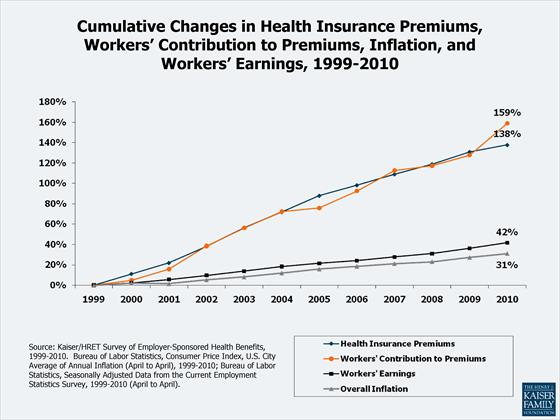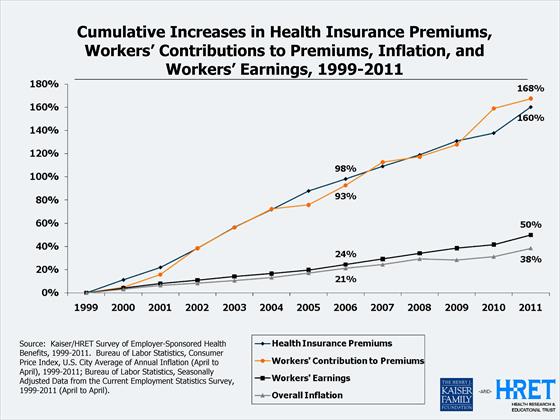Yesterday the New York Times reported that some health insurers have applied to regulatory agencies to push premiums sharply higher – usually double-digit increases, while citizens are suffering. This falls on top of the 11 year history reported last year by the Kaiser Family Foundation: wages and inflation are up ~40%, while health costs and worker contributions were up 138% and 159%:
No wonder we feel squeezed. (Yesterday’s announcement about the requested double-digit increases comes on top of this history.)
June 2012 edit: here’s an update with 2011 data, from http://facts.kff.org/chart.aspx?ch=2280:
This has enormous human impact. SPM advocate/painter Regina Holliday’s husband died partially because of inability to get care. My own life-saving exam in 2007, where my cancer was discovered coincidentally, was delayed until I had insurance. This month’s news is that 15% of Americans (45 million!) are in poverty, and this week a tweet from some conference said sixty million Americans are now uninsured.
Who will be able to stop this? As Al Mulley said at TEDx Dartmouth, who can fix healthcare?
Mulley says it’s up to us.
The SPM members’ listserv
This summer on our members-only listserv a hot discussion took place about whether healthcare is headed in the right direction. We noted that managers and policy people often arrive at policies and decisions without consulting the people who ultimately suffer or benefit from the wisdom of those acts: the patients. (And, often, the clinicians trying to accomplish care.)
I flipped back to May, when, as we noted here, SPM member Jessie Gruman’s Center for Advancing Health published its Engagement Behavior Framework. (See PDFs at bottom of that post.) Her team methodically identified 43 engagement behaviors: ways every patient will engage with the system, eventually, or have someone do it for them. CFAH groups them into ten categories:
- Find Safe, Decent Care
- Communicate with Health Care Professionals
- Organize Health Care
- Pay for Health Care
- Make Good Treatment Decisions
- Participate in Treatment
- Promote Health
- Get Preventive Health Care
- Plan for the End of Life
- Seek Health Knowledge
All good and relevant – but what about making sure the system itself is what we want??
I thought, perhaps there’s an 11th category of patient engagement:
- Design and create a safe, decent, patient centered healthcare system.
That’s participatory not just in care, but at the level of management, culture, and responsibility for care. Our definition shifts to:
Networked patients shift from being mere passengers to active drivers of their care system, and providers and leaders encourage and value them as full partners.
It would bring SDM (shared decision making) to a new level, way beyond the individual care episode. Patients and clinicians would start to define what care is.
And that just might alter our focus, as we make tough decisions about care in the era of unaffordability.








Hi Dave,
Just got back home from the Health III Session of the Salzburg Global Seminar on “Innovating for Value in Health Care Delivery: Better Cross-Border Learning, Smarter Adaptation and Adoption”
and checking my twitter timeline, I found your tweet, got intrigued by the title and here I am!!
So, Dave this is what we discussed for a week in Salzburg this time! Even one of the case studies we worked on was on three different US health insurance schemes. My group headed by Al Mulley and some 20 Fellows had to analyze and comment on the Commonwealth Care Health Insurance, a scheme based on Medicare/Medicaid to assist elder low income populations. Later, at a discussion session, I came up with a “naive” question: “all this is fine, but where are the patients, the insured, it seems like they don’t have a voice, they don’t participate in designing these care schemes that concern them”…
So you picked up a hot issue…plan to write about the big themes discussed at the seminar..
I’m so happy to hear that you were there! I would have loved to go but had other commitments already. I’m sure you represented us well.
Indeed, insurance industry: as YOU try to design solutions that you think serve us well, how much empowered, engaged patients sit on your policy committees?
(The answer may be “Many” – I’m asking!)